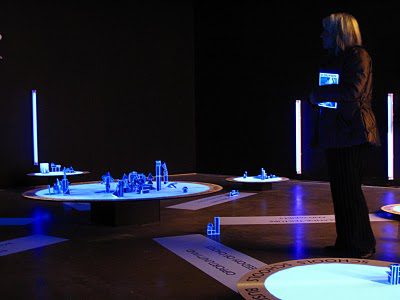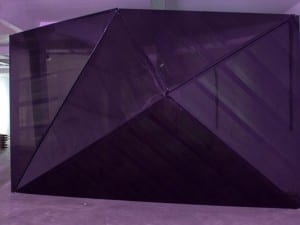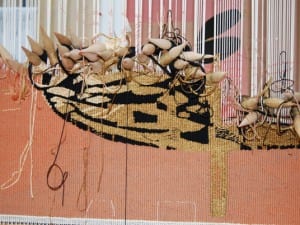Review by Nicola Mann
A long time ago, in a galaxy far, far away urban designer and theorist Melvin M. Webber devised a radical plan for a “new town” located in the then deep space hinterland between London and Birmingham. Atop a grassy plateau previously occupied by cows, sheep and swirling fog emerged Milton Keynes, a vision far in advance of its 1960s origins. Responding to Britain’s ever increasing rates of car ownership, Webber designed the town with mass automotive mobility in mind–an Americanised grid network of duel carriageways peppered with sleek roundabouts laced together shops and housing districts, lending it the air of a mini Los Angeles. Saving residents from a life sentence ensconced within the confines of their cars, Milton Keynes was also conceived as a Garden City, integrating 4000 acres of parkland, wildlife, and mazes of cycleways into its design. Love it or loath it—and the Prince Charles heritage bandwagon just loves to loath it—Milton Keynes embraced a spectacularly unique code of living.
Well, until today that is. Subject to “densification” orders from central government, Milton Keynes recently morphed into the kind of town it was most often accused of being but nevertheless proudly resisted. Milton Keynes became a non-place, marked by voluminous Amazon and Argos warehouses, predictable high-rises, and homogeneous chain pubs. Akin to a giant conveyor belt in an airport departure lounge, MK as it’s commonly abbreviated, is now as bleak and transient as the indoor ski slope that now dominates its skyline, leading some residents to ask for the first available flight out.
This month Leeds-based art collective Black Dogs step into this vortex, determined to reinstate residents as central stars in the town’s planning process. Except the artists’ projected (new) new town isn’t just another tacked on amendment to MK’s existing boulevards and business districts: this MK2 is, quite literally, a whole new world. Inspired by the recent scientific discovery of Gliese 581g, an inhabitable planet outside our solar system, MK2Morrow: One Small Step for Milton Keynes proposes that as pioneers of their own little planet, the town’s residents stand best equipped to manage the design of the new space colony. The exhibition asks: “What do you wish to retain, fabricate and develop of the original MK and what will the towns and cities look like?”
The first of three themed rooms invites visitors to provide answers to these questions by contributing to “The MK2 Survival Kit.” Tacked on the gallery walls, residents’ “how to” cards encircle a glossy revolving prototype of this skills-bible like small planets orbiting the sun. The highlights of the exhibition, these amusing nuggets of wisdom include instructions on “vital” life necessities such as how to dance, -cure a hangover, -roll a rollie, -play a heavy riff, and my own personal favourite, how to weigh a dog. “Will such life-skills prove indispensable to the future generations of MK?” ask the artists. Probably not, but what saves this from being a mean-spirited backhanded swipe at the “cultural legacy” of MK (or lack thereof), is the self-deprecating nature of the step-by-step guides and diagrams. Only a town as affable as MK could produce type-written instructions on how to organise a serious peace protest at the same time as offering a child’s guide to constructing a bunch-of-grapes fancy dress costume.
The audience-generated nature of the exhibition continues in the next room where visitors are invited to assume the role of architect and city-planner via the “Massive Tiny Space Colony” installation. Prior to the show’s opening earlier this month, Black Dogs distributed packs of postcards around MK leaving those that find them with materials to create small architectural models of the homes they would like to live in. Perhaps reflecting the sticky-back plastic Blue Peter-ness of this request, the resulting city plan–conceived around a cardboard land use model designating facilities (housing, schools, roads, church, etc) and values (public awareness and participation, etc)–has the feeling of an end of term trip to the Science Museum. Flickering strobe lighting fails to enliven a somewhat tired educational agenda, which lacks the frivolity and ad hoc originality of the previous room.
Madness returns in the form of a Smithsonian-style recreation of what Black Dogs predict will become the lasting symbol of community life in MK in years to come. So, what should every great society revere as its very own memory palace? A theatre? Schools? An exit portal to get you home should the galaxy be set upon by the Sith Army? No, as any English person worth their salt knows, the pinnacle of any town is, of course, the good old pub. Here, in the darkened realms of the third and final themed room, visitors find “The Pub at the End of the Universe”, bedecked with all the trappings of a traditional drinking experience: flocked wallpaper, Mr. Porky snacks, and the unmistakable squelch of beer-stained carpets. While supping London Pride, visitors are again asked to share stories, anecdotes, facts and fiction relating to MK on postcards dotted around the wooden bar. This is all great, except for the fact that unless you’re mad or an alcoholic (or both) no one wants to wax lyrical about the “good old days” by themselves, do they? On that cold wintry afternoon, I was the sole sad visitor to the “pub” and this is where the challenge for the exhibition lies. While fantastically original in theory—the artists have an important point to make about what defines a “community” as well as the government’s involvement in the nation’s housing–they need bums on bar stools to make it a success. At the moment, the proposed MK2 space colony is more New Romney than New York.
Carve out some space in your schedule to make the pilgrimage to MKGallery before the show closes on 2 January 2011. www.mkgallery.org





